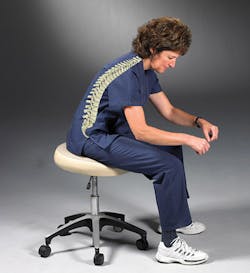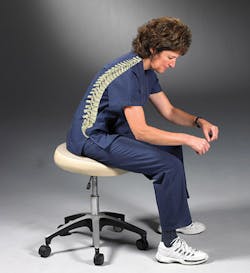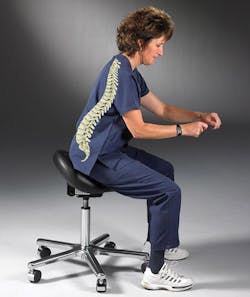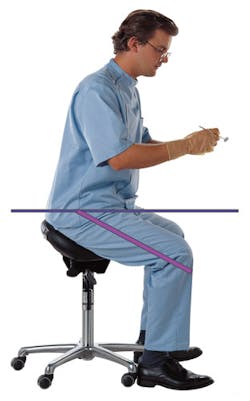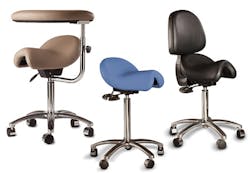Taking the backache out of practicing
Gregori M. Kurtzman, DDS, MAGD, DICOI
Figure 1: Curvature of the spine when using a traditional flat chair forms a "C" shape, creating strain at the lumbar region.
Those involved in clinical practice, be it as dentists, hygienists, or assistants, are prone to back issues. These include lower back and neck problems that relate to how they position themselves while rendering treatment. Based on how they tend to position themselves, differences can be denoted between those rendering treatment (dentists and hygienists) and those assisting.
Hayes reported in a systematic review that the most prevalent regions for pain in dentists have been shown to be the back (36.3-60.1%) and neck (19.8-85%).1 A meta-analysis reported a combined prevalence of 53.90% for thoracic-lumbar pain, 41.23% for lower back pain, and 41.39% for neck pain.2 The musculoskeletal pain mechanism has been attributed to poor ergonomic work posture and position adopted by dentists in relation to their patients.3 The prevalence of musculoskeletal disorders among dental personnel is high and a critical need exists to enhance awareness regarding correct working postures.4
Why do we have a high tendency toward lower back and neck pain? Most practitioners subconsciously tend to lean toward the patient when rendering treatment to improve visualization. Additionally, practitioners tend to rotate and bend their heads to better visualize the maxilla, instead of better positioning the patient and using indirect visualization (i.e., using a mirror). As practitioners age and it becomes more difficult to see small objects, they tend to lean in further, placing more strain on the neck and lower back. Use of loupes helps improve visualization but also forces the practitioner to sit more upright due to the focal distance of the loupes. When the practitioner wearing loupes leans in closer to the patient, the field of view blurs (goes out of focus), subconsciously forcing them to sit in a more upright position to bring the subject into focus.
Unfortunately, most dental chairs-due to their design-still allow the practitioner to lean forward while rendering treatment. This causes stress to be placed on the lower back, the spine's weakest area. Traditional dental operator chairs cause the spine to curve into a "C" shape, placing strain on the lower back (figure 1). This unnatural curvature of the spine increases stress on the fourth and fifth lumbar discs, the classic trouble spot in the back. The ideal angle between the spine and hips is 45 to 50 degrees before strain is noticed in the lumbar region. Use of a flat chair tends to create an angle of 90 degrees, causing the back to form the "C" shape to compensate and leading to telltale lumbar issues.
A less stressful alternative
After a series of auto accidents, starting a month before graduation from dental school, my lower back and neck had developed some cumulative damage. At times, this made practice uncomfortable with radiating pain toward the end of long days of patient treatment. Traditional dental chairs placed pressure on my coccyx, which would bend my lower lumbar area into what felt like an unnatural position, leading to strain in this area. So, I learned to practice standing. A friend mentioned looking into saddle chairs, and I had the opportunity to try one at a conference at an exhibitor's booth. As with most things in life, there was an adaptation process. In this case, it took about a week for me. But, at the end of the first day, I noticed my back felt less strained, and I had less pressure in the lumbar area. As I entered into the second week of use of the saddle chair, I noticed more comfort during long procedures. Now, after using my new chair for several months, my back feels almost like new.
Figure 3: Positioning on the Bambach saddle chair is important. Knees should be positioned lower than the hips to create the optimal 45 degree angle between the spine and hips.
Saddle chairs, such as the Bambach (Hager Worldwide, figure 4), help preserve the natural "S" curvature of the spine, removing strain from the lumbar area (figure 2). Additionally, due to the seat shape, the spine-hip angle is kept at an optimal 45 degrees. This allows the back and thigh muscles to be at their most relaxed positions. Use of the Bambach saddle chair has been shown to maintain an acceptable working posture that may reduce the development of work-related musculoskeletal disorders.5
Additionally, with proper posture during treatment, stress and strain is taken off of the shoulders. When using a flat chair, the operator will elevate the elbows while leaning forward and working. This places increased stress on the shoulders, which in turn is transmitted to the neck, leading to orthopedic issues over time. It also leads to fatigue after shorter periods of work. Conversely, chairs such as the Bambach position the operator more upright with the elbows positioned closer to the body in a more natural position. This takes strain off the shoulders and lessens fatigue during long treatments or busy days.
Typically, when seated in a flat chair, the operator tends to position him- or herself so that the knees are at the same level as the hips (horizontal and parallel with the floor). Proper positioning in the Bambach chair-so that the hips are at the optimal angle-requires the knees to be positioned slightly lower than the hips to create an angle with the horizontal plane. This aids in removing loading off the lumbar region (figure 3). It is also recommended that if the practitioner is planning on changing loupes or acquiring a set, the working distance be measured while seated in the saddle chair and the patient ideally positioned. This will ensure the ideal working distance.
Conclusion
Doctors and hygienists spend a large portion of their day seated and rendering treatment. Over time, stress and strain in the lumbar region and also the neck can lead to degenerative changes that can affect not only how we practice, but the quality of life both in and out of the operatory. Chairs like the Bambach position the operator in the correct position, with the optimal angle between the spine and hips, relieving stress in the lumbar area. Less physical stress when rendering treatment results in better health, especially as we age.
References
1. Hayes M, Cockrell D, Smith DR. A systematic review of musculoskeletal disorders among dental professionals. Int J Dent Hyg. 2009;7:159-65. doi: 10.1111/j.1601-5037.2009.00395.x.
2. Chikte UM, Khondowe O, Louw Q, Musekiwa A. A meta analysis of the prevalence of spinal pain among dentists. SADJ. 2011;66:214-8.
3. Ellapen TJ, Narsigan S, van Herdeen HJ, Pillay K, Rugbeer N. Impact of poor dental ergonomical practice. SADJ. 2011;66:272, 274-7.
4. Kanteshwari K, Sridhar R, Mishra AK, Shirahatti R, Maru R, Bhusari P. Correlation of awareness and practice of working postures with prevalence of musculoskeletal disorders among dental professionals. Gen Dent. 2011;59:476-83; quiz 484-5.
5. Gandavadi A, Ramsay JR, Burke FJ. Assessment of dental student posture in two seating conditions using RULA methodology - a pilot study. Br Dent J. 2007;203:601-5.
Gregori M. Kurtzman, DDS, MAGD, DICOI, is in private general practice in Silver Spring, Maryland. He has lectured internationally on the topics of restorative dentistry, endodontics, implant surgery, prosthetics, and periodontics. He has nearly 400 published articles and has earned fellowship in the AGD, AAIP, ACD, ICOI, Pierre Fauchard, ADI; mastership in the AGD and ICOI; and diplomate status in the ICOI and ADIA. He can be reached at [email protected].
